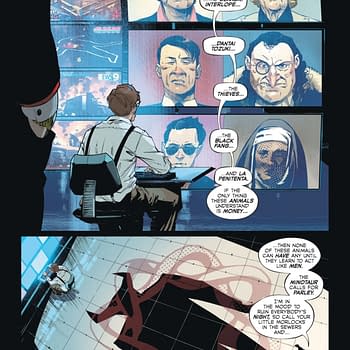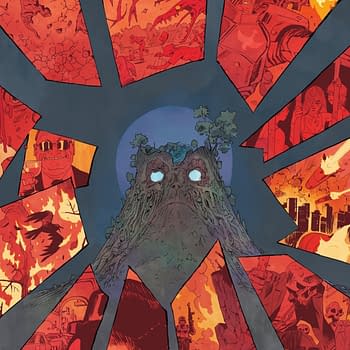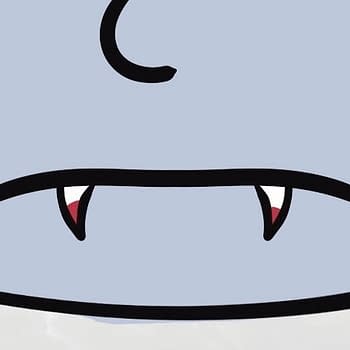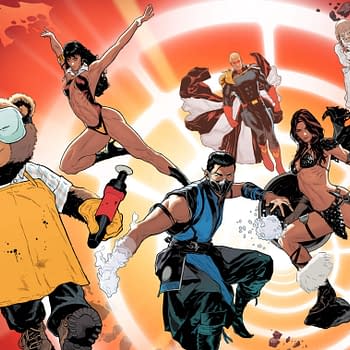Posted in: Comics | Tagged: Batman, Comics, dc, death of the family, joker, Review, scott snyder
Tuesday Review: Batman #14 – The Joker Knows E-V-E-R-Y-T-H-I-N-G
Will Romine writes for Bleeding Cool. Thar be spoilers, arr, so thar be;
Ahoy-hoy Friends!
I've managed to get my paws on Batman #14, the latest installment of the "Death in the Family" story arc. For those of you keeping score at home, there have been three issues thus far branded as DOTF tie ins,. However, this is where it begins; this is where shit gets real! At New York Comic Con, the book's main scribe, Scott Snyder, revealed that the Joker's comeback tour targets two groups: the Bat-Family and the Bat-Rogues. Accordingly, the issue is divided into two parts, the story proper, and a backup featuring the Penguin. Batman #13 followed this structure and Snyder tells me that subsequent Batman issues will follow this formula, with Riddler and Two-Face backing up issues #15 and #16 respectively.

The Joker sees this relationship, but Batman is blind to it. Though Batman loathes Joker strives to lock him in the deepest recesses of Arkham for the remainder of his life, only Joker can see how he strengthens Batman. If Batman's greatest foe is his best source of strength, then it stands to reason that his strongest allies may be slowing him down. As Joker puts it at the end of this issue, "[Batman] can't even cage a few owls without [the Bat-Family's] help anymore."
In many ways, "Death of the Family" could also be called "Whatever Happened to the Clown Prince of Crime?" The other two "Whatever Happened to.." arcs told "final" stories of Batman and Superman and did so in a way that recognized and honored the history of these characters. If "Whatever Happened to the Man of Tomorrow" was a farewell to the Silver-Age Superman, and "Whatever Happened to the Caped Crusader" was a sendoff to the idea of a single, valid interpretation of Batman, then perhaps "Whatever Happened to the Clown Prince of Crime" will disavow us of the notion that acts capriciously and without an endgame in sight.
DOTF touches on Joker's past crimes (paralleling the TP "The Man who Laughs"), but also goes down to the root of the Joker's character. Christopher Nolan's "The Dark Knight" presented a Joker who thrived on chaos and rejected any planning or governing ethos. Similarly, this issue has Jim Gordon contrasting Joker with other Bat-Rogues commenting, "if you're a good enough detective, you can get some inkling of what [the other rogues's] next move might be, but with him, all you can do is react." I believe that is the biggest mistake people make about the Joker. The Joker isn't godless, he just prays to a different set of gods.
The Joker does have a plan, but it's based on a set of goals that are so counterintuitive, so twisted, that the only direct and sensical means to achieve those ends are through the slaughter of innocents in the service of a knock-knock joke, or the dismembering of everyone named "Armstrong." What's unsettling about the idea of the "planning" Joker is that the obvious objectives of his crimes (money, mayhem, etc.) are fringe benefits in the service of a greater goal. Bruce Wayne trained tirelessly to avenge the death of his parents. He wanted to prevent what happened to him from happening to another child. It's an understandable motivation, but one that could carry few of us to become Batman; we understand the cause, but marvel at the effect. Similarly, if we accept the idea of the "planning" Joker, we must also accept a similarly strong impetus for his psychotic violence.
The backup story sheds some light on what motivates the Joker. The second half of this issue involves a meet-up between the Penguin and Joker, where the Joker hopes to co-opt the Penguin into his plans for targeting the Bat-Family. Though Joker doesn't go into specifics, he extends the allegory of Gotham as a kingdom to elevate Batman to a God-King. If he is a God, then Gotham's criminal element are his worshipers.
The idea of crime as a religion isn't a new idea in the DC universe, but never before has a hero been its chief deity. The Joker demonstrates why he isn't any ordinary member of the congregation. The Joker isn't motivated by greed or revenge, the two main impeti for most of Gotham's rogues. Instead, he has elevated Batman to his patron saint and devoted himself to the Altar of the Bat. Except, rather than light votive candles or leave food offerings, he kills and maims.
Overall, I thought this issue started out at a deliberate pace, but then shot through the stratosphere. "Death of the Family" starts here. I'm not saying that you shouldn't pick up the other books, but this issue is where you learn what this arc is all about. I'm curious as to how Joker's plans will materialize. As for the artwork, you can tell that Greg Capullo is really having fun drawing the Joker's strap-on face. I'm afraid to know what he uses as a life model, but his interpretation of a desiccated face reattached by duct tape and string makes sense. Sometimes I bite holes into a tortilla and try to wear it as a face, so I know what I'm talking about.
As for the title of this article. Yes, the Joker knows everything, including that biggest of secrets.
Batman #14 is published tomorrow by DC Comics.













